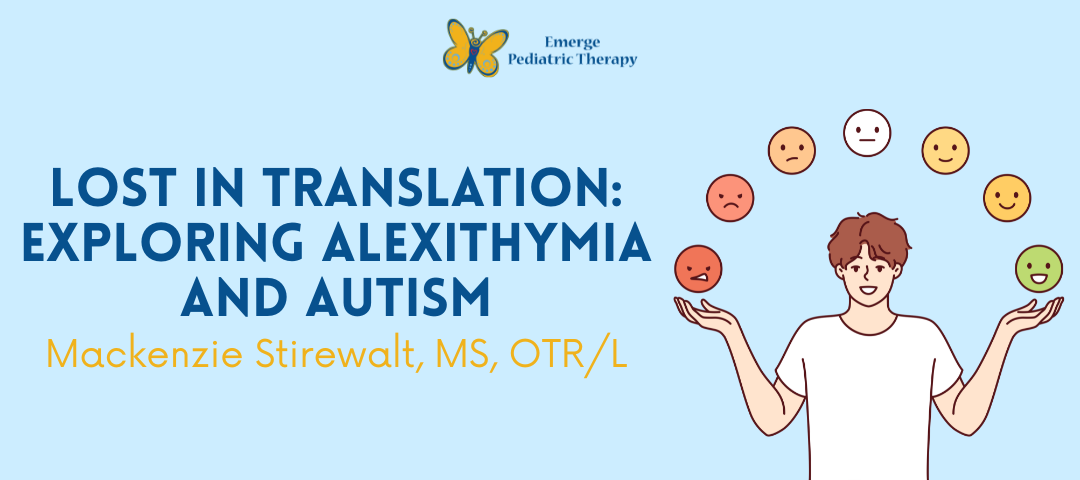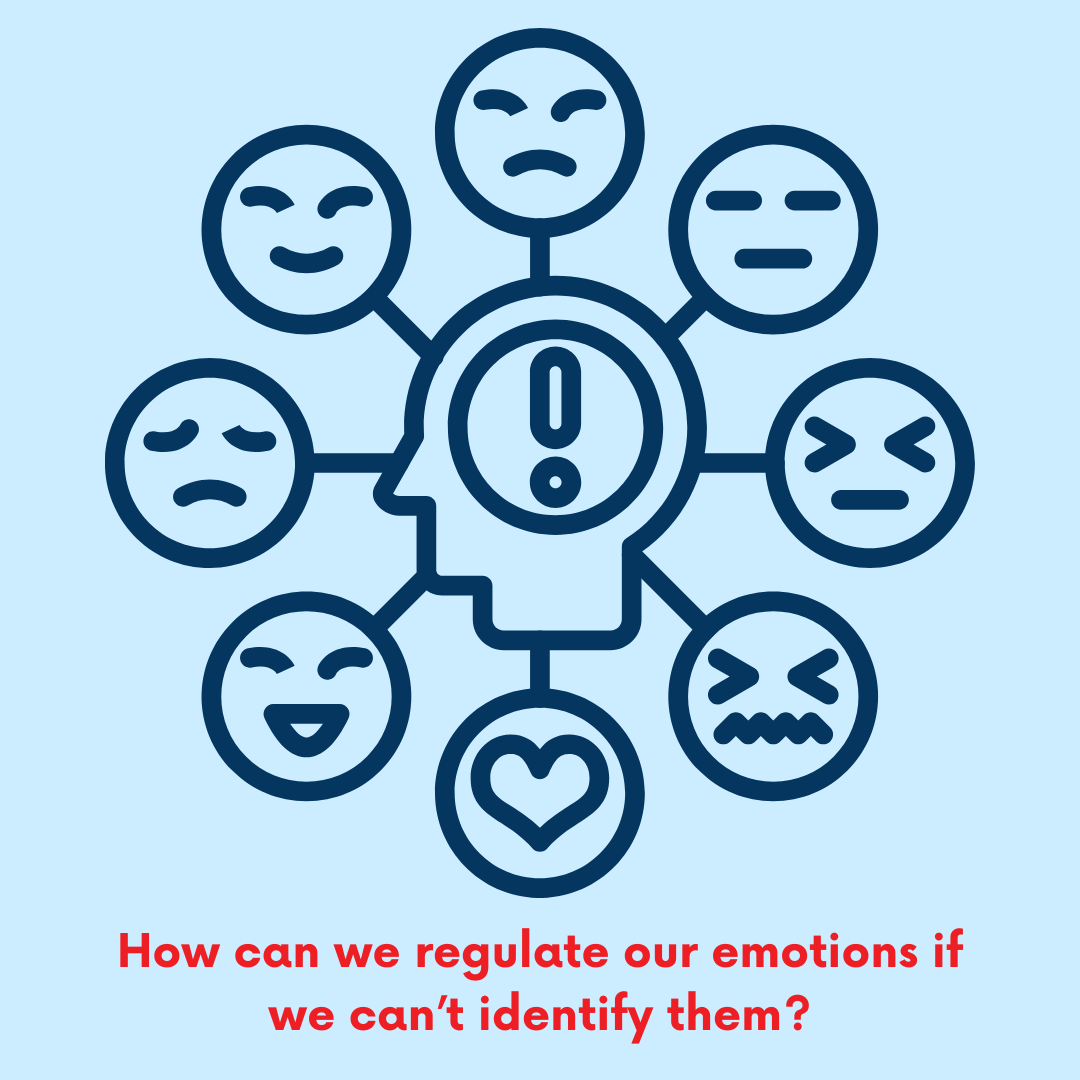
We often try to “walk a mile in someone else’s shoes,” and view the world through another person’s experiences as a way to connect. But what if identifying the emotions of others, or even the emotions we experience within ourselves, was something that always seemed just out of reach?
Alexithymia is a term with Greek roots that directly translates to “no words for emotions.” It is used to describe when an individual has distinct difficulties with identifying, understanding, and expressing emotions, either in themselves or others. It is categorized as a personality trait and not a diagnosable disorder. Alexithymia can make it exceptionally challenging to know what emotions we are experiencing, how to express them, and to “walk a mile in someone else’s shoes.”
So why is alexithymia so important to discuss in relation to autism, when both autistic and allistic individuals can have alexithymia?
Research has shown that alexithymia is significantly more prevalent in autistic people, with most studies indicating that at least half of autistic individuals also have alexithymia. With research also indicating that autistic individuals with alexithymia are more likely to have lower self-esteem, depression, anxiety, eating disorders, and higher rates of substance abuse, it is clear that understanding and addressing the impact of alexithymia in autistic individuals may play a crucial role in reducing negative outcomes from mental health challenges and improving overall quality of life.
It is also important to note that though alexithymia can occur genetically, it can also be developed due to psychological stress or trauma. In fact, holocaust survivors and sexual assault victims also experience higher levels of alexithymia for this reason. Unfortunately, this can mean that autistic children who experience excessive stress from consistent breakdowns in communication or self-expression may develop alexithymia as a type of defense mechanism against highly emotional events. In a YouTube video by Amythest Schaber, an individual with autism, they stated, “Some autistic people I’ve spoken to believe that they didn’t always have Alexithymia, but they developed it when their attempts to express themselves or emote were met with disdain, disapproval, or anger from non-autistic people in their lives.”
Autistic individuals with alexithymia may struggle to sense physical symptoms that indicate the emotions that they are experiencing. Common physical indicators of emotions, such as “butterflies in the stomach” or feeling heat in the face when embarrassed, may not be immediately associated with emotional shifts. This can also amplify anxiety, as autistic people register these feelings but can’t identify why they are occurring. Furthermore, differences in sensory processing and interoception can affect the internal sensations of the body and how an individual registers and differentiates between them. Specifically, interoception refers to the perception of internal bodily sensations, such as heart rate, hunger, and – you guessed it – emotions. These differences can compound the challenges of identifying, understanding, expressing, and managing emotions, otherwise known as emotional regulation.
When it comes to emotional regulation, accepting our emotions can often serve as a crucial step to managing them and engaging in our daily life. However, if we cannot identify the emotion we are experiencing in the first place, it is significantly harder to acknowledge and accept it, and therefore more difficult to regulate emotions as a whole. Additionally, a limited understanding of our inner experiences and emotions impacts how we relate to others’ experiences and emotions. Cognitive empathy is the act of mentally placing yourself into someone else’s experience, and it is more difficult for individuals with alexithymia due to not identifying and experiencing their emotions in the same way that people without alexithymia do. This challenge with empathy can also increase challenges with social interactions.

It is important to note that there is a harmful stereotype that is prolific in media and popular culture regarding autistic individuals having a lack of empathy. This stereotype has been made popular through TV shows such as Young Sheldon, The Good Doctor, and Atypical. However, these characters, and the assumptions about autistic individuals having a lack of empathy, are better explained by severe alexithymia in autistic people. This combination has become the cultural archetype of autism, which has perpetuated a viewpoint that autistic individuals are not empathetic while also increasing the misdiagnosis of women or genderqueer individuals.
Geoff Bird conducted a study that measured the degree of brain activity evoked by a loved one’s pain. The study found that there was no difference in the degree of empathic brain activity between autistic and allistic individuals, but there was a notable difference between individuals with alexithymia and those without. Therefore, many of the stereotypical assumptions about autism are better explained by alexithymia and are not intrinsic to autism itself – autistic individuals are some of the most empathetic people! According to research by Adam Smith, autistic individuals might even have elevated levels of empathy. Furthermore, the double empathy problem has proven that autistic individuals do not experience difficulty empathizing with each other, and that challenges with empathy most often occur between autistic and allistic people due to “a breakdown in reciprocity and mutual understanding that can happen between people with very differing ways of experiencing the world,” according to the National Autistic Society.
Despite this, autistic individuals with alexithymia may experience difficulty identifying what others are feeling. When they don’t respond in the way that allistic people anticipate, a lack of empathy may be wrongfully assumed. Autistic social-communication difficulties are often exaggerated by the limited awareness of emotions and emotional regulation challenges that severe alexithymia can cause. However, alexithymia can sometimes be a strength! In particular, individuals with alexithymia can make great paramedics or rescue officers due to their ability to remain calm under pressure during highly emotional situations.
Through the website Autistica, one individual stated, “Just because I struggle to put how I feel into words it doesn’t mean I don’t feel things. In fact, the worse I feel, the more I struggle and often default to, “I’m fine.” Furthermore, emotions must be processed, whether they are consciously experienced or suppressed, and if they are unable to be processed and expressed directly, they often present physically. This could also result in aggressive behaviors in autistic individuals who struggle with identifying and expressing their emotions, as there is no other available method for processing how they feel. Compounding this challenge is the fact that research has found alexithymia in autistic children to reduce the frequency of parent-child interactions, and that difficulty communicating their inner experiences may result in decreased opportunities for co-regulation and negatively impact overall development of regulation skills and parent-child relationships.
This begs the question: what can be done to improve emotional regulation through identification and expression for individuals with alexithymia, particularly people who are also autistic? Below is a list of suggestions that can be utilized personally, through therapeutic services, or to support other people in your life who may have alexithymia.
- Process internal emotions by externally moving your body in beneficial ways, such as going for a walk, practicing yoga, or dancing
- Giving plenty of time to reflect, process, and express. If you are talking with someone who has alexithymia, try not to ask too many questions at once.
- Provide opportunities to process through emotions and bodily sensations without judgement or shame. Acknowledge every attempt to express, communicate, and connect
- Engage in a variety of perspective-taking activities, such as reading stories and reflecting on what the characters are experiencing, playing Dungeons and Dragons or other role-playing games, including video games.
- For young children, modeling emotions and narrating what you are experiencing can provide a good example and reference for emotions
Blog by Mackenzie Stirewalt, MS, OTR/L
REFERENCES:
- Cameron, K., Ogrodniczuk, J., & Hadjipavlou, G. (2014). Changes in alexithymia following psychological intervention: a review. Harvard Review of Psychiatry, 22(3), 162–178. https://doi.org/10.1097/HRP.0000000000000036
- Levant, R. F., Allen, P. A., & Lien, M.-C. (2014). Alexithymia in men: How and when do emotional processing deficiencies occur? Psychology of Men & Masculinity, 15(3), 324–334. https://doi.org/10.1037/a0033860
- Ricciardi, L., Demartini, B., Fotopoulou, A., & Edwards, M. J. (2015). Alexithymia in neurological disease: A review. The Journal of Neuropsychiatry and Clinical Neurosciences, 27(3), 179–187. https://doi.org/10.1176/appi.neuropsych.14070169
autistica.org.uk | sciencedirect.com | pmc.ncbi.nlm.nih.gov | mdpi.com | tandfonline.com | autistica.org.uk | musingsofanaspie.com | reframingautism.org | embrace-autism.com | neurodivergentinsights.com | autism.org.uk
